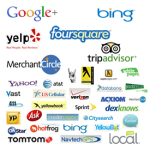 With more people getting all of their information online, it can be very hard to control your reputation. Information online gets passed from person to person quicker with the birth of social media marketing, plus people can put any information online whether it is true or not. It means that not only do you have to shake hands and kiss babies to maintain a positive reputation, but you also have to be very active and aware online. Here are five tips to help with online reputation management so that it matches your offline one.
With more people getting all of their information online, it can be very hard to control your reputation. Information online gets passed from person to person quicker with the birth of social media marketing, plus people can put any information online whether it is true or not. It means that not only do you have to shake hands and kiss babies to maintain a positive reputation, but you also have to be very active and aware online. Here are five tips to help with online reputation management so that it matches your offline one.
Everything is Public
Even if you try to keep personal accounts and public accounts separate, it is still impossible to ensure that everything you want to be private stays that way. Forbes recommends that you do not put anything online unless you wouldn’t care if the whole world saw it. This way, even if something does get out from your personal account, it won’t cause any damage to your reputation.
Combat Negative Reviews
One of the biggest things that will impact your online reputation is the reviews that you get online. Unfortunately, people who are upset are more likely to leave reviews. The first step to combating negative reviews is knowing when they are posted. With the help of companies like Reputation.com, you can get alerts whenever a negative review is posted on a variety of sites, including Yelp and Google. That way, you can go in and address the review, leaving a comment to demonstrate that you care about their concerns.
Another way to counteract negative reviews is to get more positive ones. You can do this by asking your in-person customers if they would be willing to leave you an honest review online. Before long, Reputation.com will be able to track the results of your efforts by showing more positive reviews.
Spread the Wealth
There are bound to be some things posted about you online that you would rather not be there. While you cannot do anything to get rid of them, you can counteract them by spreading positive things about you all over the web. CIO points out that if you do this, when your name is searched, the positive items will show up over the negative ones. Have a strong presence through every facet of social media, including Facebook, LinkedIn, YouTube, Pinterest and Google+. Every keyword counts.
Be Active Online
Having a presence in social media is not enough. It is a great way to build up your search rankings, but you also need to respond to customers comments and concerns that are made via social media platforms. According to ReachCast, 60 percent of people who leave comments on social media pages expect a response. If you are not leaving responses, you are upsetting a large portion of your customer base. When you do comment, you need to acknowledge the concerns or express gratitude for the comments. Never argue.
Everything is Permanent
However you interact online, remember that everything you do is permanent. Even if the people involved will forget the instance in the near future, it is always searchable, and therefore, it can always impact your online reputation.
While your in-person actions can only be seen by those around you and can be forgotten over time, your online reputation lasts forever. It is vital that you take the time to ensure that you have an online reputation management procedure.


